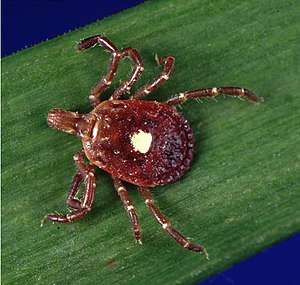Oribatida
| Oribatida | |
|---|---|
 | |
| Unidentified mite (Phthiracaridae) | |
| Scientific classification | |
| Kingdom: | Animalia |
| Phylum: | Arthropoda |
| Subphylum: | Chelicerata |
| Class: | Arachnida |
| Subclass: | Acari |
| Superorder: | Acariformes |
| Order: | Oribatida Dugès, 1833 |
| Suborders | |
| |
| Diversity | |
| c. 200 families, 1,200 genera, 6,600 species | |
| Synonyms | |
|
Cryptostigmata | |
Oribatida (formerly Cryptostigmata), also known as moss mites or beetle mites,[1] are an order of mites, in the "chewing Acariformes" clade Sarcoptiformes. They range in size from 0.2 to 1.4 millimetres (0.008 to 0.055 in).[1]
Oribatid mites generally have low metabolic rates, slow development and low fecundity.[1] Species are iteroparous with adults living a relatively long time; for example, estimates of development time from egg to adult vary from several months to two years in temperate forest soils.[1] Oribatid mites have six active instars: prelarva, larva, 3 nymphal instars and the adult.[1] All these stages after the prelarva feed on a wide variety of material including living and dead plant and fungal material, lichens and carrion; some are predatory, but none is parasitic and feeding habits may differ between immatures and adults of the same species. Many species have a mineralized exoskeleton.[2][3]
The Oribatida are of economic importance as hosts of various tapeworm species, and by increasing the breakdown of organic material in the soil, in a similar manner to earthworms.[4]
Systematics
Oribatida is divided into the following taxa:[5]
- Palaeosomata Grandjean, 1969
- Acaronychoidea Grandjean, 1932 (6 genera)
- Acaronychidae Grandjean, 1932
- Palaeacaroidea Grandjean, 1932 (8 genera)
- Palaeacaridae Grandjean, 1932
- Parhyposomata Balogh & Mahunka, 1979
- Parhypochthonioidea Grandjean, 1969 (3 genera)
- Parhypochthoniidae Grandjean, 1969
- Gehypochthoniidae Strenzke, 1963
- Elliptochthoniidae Norton, 1975
- Enarthronota Grandjean, 1947
- Hypochthonoidea Berlese, 1910 (c. 8 genera)
- Hypochthoniidae Berlese, 1910
- Eniochthoniidae Grandjean, 1947
- Arborichthoniidae Balogh & Balogh, 1992
- Brachychthonoidea Thor, 1934 (c. 11 genera)
- Brachychthoniidae Thor, 1934
- Cosmochthonioidea Grandjean, 1947 (c. 14 genera)
- Cosmochthoniidae Grandjean, 1947
- Heterochthoniidae Grandjean, 1954
- Haplochthoniidae Hammen, 1959
- Pediculochelidae Lavoipierre, 1946
- Sphaerochthoniidae Grandjean, 1947
- Atopochthonioidea Grandjean, 1949 (3 genera)
- Atopochthoniidae Grandjean, 1949
- Pterochthoniidae Grandjean, 1950
- Phyllochthoniidae Travé, 1967
- Protoplophoroidea Ewing, 1917 (c. 7 genera)
- Protoplophoridae Ewing, 1917
- Mixonomata Grandjean, 1969
- Dichosomata Balogh & Mahunka, 1979
- Nehypochthonioidea Norton & Metz, 1980
- Nehypochthoniidae Norton & Metz, 1980
- Perlohmannioidea Grandjean, 1954
- Perlohmaniidae Grandjean, 1954
- Collohmanniidae Grandjean, 1958
- Eulohmannioidea Grandjean, 1931
- Eulohmanniidae Grandjean, 1931
- Epilohmannioidea Oudemans, 1923
- Epilohmanniidae Oudemans, 1923
- Lohmannioidea Berlese, 1916
- Lohmanniidae Berlese, 1916
- Euptyctima Grandjean, 1967
- Mesoplophoroidea Ewing, 1917
- Mesoplophoridae Ewing, 1917
- Euphthiracaroidea Jacot, 1930
- Oribotritiidae Grandjean, 1954
- Euphthiracaridae Jacot, 1930
- Synichotritiidae Walker, 1965
- Phthiracaroidea Perty, 1841
- Phthiracaridae Perty, 1841
- Steganacaridae Niedbała, 1986
- Holosomata Grandjean, 1969
- Crotonioidea Thorell, 1876
- Thrypochthoniidae Willmann, 1931
- Malaconothridae Berlese, 1916
- Nothridae Berlese, 1896
- Camisiidae Oudemans, 1900
- Crotoniidae Thorell, 1876
- Nanhermannioidea Sellnick, 1928
- Nanhermanniidae Sellnick, 1928
- Hermannioidea Sellnick, 1928
- Hermanniidae Sellnick, 1928
- Brachypylina Hull, 1918
- Pycnonoticae Grandjean, 1954
- Hermannielloidea Grandjean, 1934 (2 families)
- Neoliodoidea Sellnick, 1928 (1 family)
- Plateremaeoidea Trägårdh, 1926 (4 families)
- Gymnodamaeoidea Grandjean, 1954 (2 families)
- Damaeoidea Berlese, 1896 (1 family)
- Polypterozetoidea Grandjean, 1959 (2 families)
- Cepheoidea Berlese, 1896 (7 families)
- Charassobatoidea Grandjean, 1958 (3 families)
- Microzetoidea Grandjean, 1936 (1 family)
- Zetorchestoidea Michael, 1898 (1 family)
- Gustavioidea Oudemans, 1900 (8 families)
- Eremaeoidea Oudemans, 1900 (4 families)
- Amerobelboidea Grandjean, 1954 (10 families)
- Eremelloidea Balogh, 1961 (7 families)
- Oppioidea Sellnick, 1937 (12 families)
- Trizetoidea Ewing, 1917 (6 families)
- Otocepheoidea Balogh, 1961 (4 families)
- Carabodoidea Koch, 1837 (3 families)
- Tectocepheoidea Grandjean, 1954 (2 families)
- Hydrozetoidea Grandjean, 1954 (1 family)
- Ameronothroidea Willmann, 1931 (3 families)
- Cymbaeremaeoidea Sellnick, 1928 (3 families)
- Poronoticae Grandjean, 1954
- Licneremaeoidea Grandjean, 1931 (6 families)
- Phenopelopoidea Petrunkevitch, 1955 (1 family)
- Unduloribatoidea Kunst, 1971 (3 families)
- Limnozetoidea Thor, 1937 (2 families)
- Achipterioidea Thor, 1929 (2 families)
- Oribatelloidea Jacot, 1925 (3 families)
- Ceratozetoidea Jacot, 1925 (5 families)
- Zetomotrichoidea Grandjean, 1934 (1 family)
- Oripodoidea Jacot, 1925 (19 families)
- Galumnoidea Jacot, 1925 (3 families)
See also
References
- 1 2 3 4 5 Marjorie A. Hoy (2008). "Soil mites". In John L. Capinera. Encyclopedia of Entomology, Volume 1 (2nd ed.). Springer. pp. 3463–3466. ISBN 978-1-4020-6242-1.
- ↑ Mites: Ecology, Evolution & Behaviour: Life at a Microscale
- ↑ Calcium carbonate and calcium oxalate as cuticular hardening agents in oribatid mites (Acari: Oribatida)
- ↑ Edward W. Baker & G. W. Wharton (1952). "Oribatei Dugès, 1833". An Introduction to Acarology. New York: Macmillan. pp. 387–438.
- ↑ Luis S. Subías (2007). "Listado sistemático, sinonímico y biogeográfico de los ácaros oribátidos (Acariformes: Oribatida) del mundo (Excepto fósiles)" [Systematic and biogeographic list, with synonymies, of the oribatid mites (Acariformes: Oribatida) of the world (excluding fossils)] (PDF) (in Spanish). Retrieved January 5, 2008.
Further reading
| Wikimedia Commons has media related to Oribatida. |
- Krantz, G. W. (1978). A Manual of Acarology (2nd ed.). Corvallis, OR: Oregon State University. ISBN 978-0-88246-064-2.
- Halliday, R. B.; D. E. Walter; H. C. Proctor; R. A. Norton; M. J. Colloff, eds. (2001). Acarology, Proceedings of the 10th International Congress. Melbourne: CSIRO Publishing. pp. 1–960. ISBN 0-643-06658-6.
- Walter, D. E. & H. C. Proctor (2001). Mites in Soil, An interactive key to mites and other soil microarthropods. ABRS Identification Series. Collingwood, Victoria: CSIRO Publishing. ISBN 978-0-643-06790-5.
- Woolley, Tyler A. (1988). Acarology: Mites and Human Welfare. New York, NY: Wiley Interscience. ISBN 978-0-471-04168-9.
- Niedbala, Wojciech (1992). Phthiracaroidea (Acari, Oribatida): Systematic Studies. Warsaw, Poland: PWN + Elsevier. ISBN 978-8-301-09740-0.
